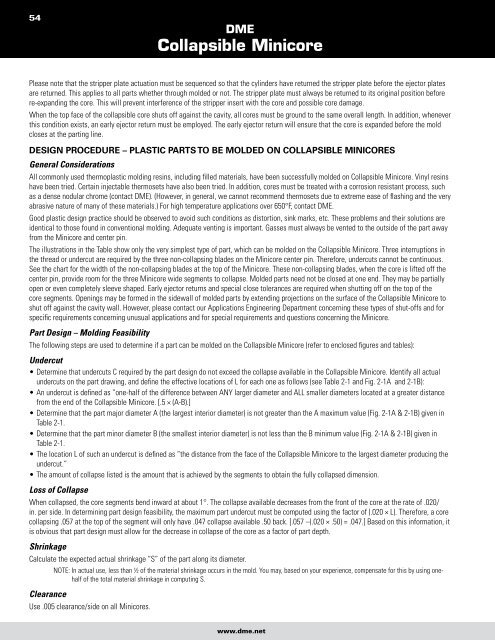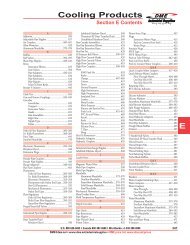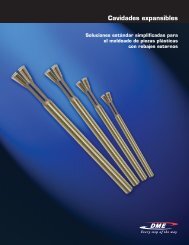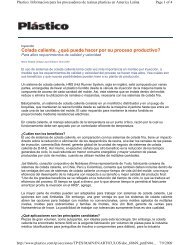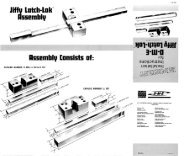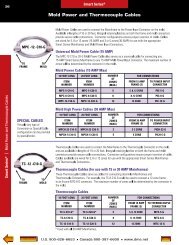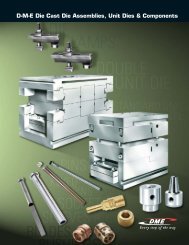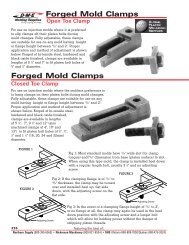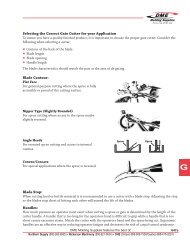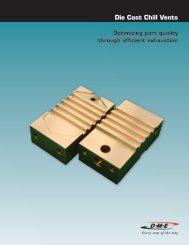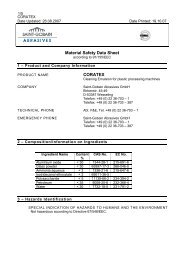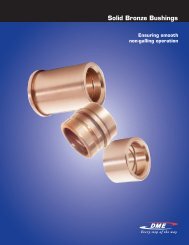Collapsible Core Design & Assembly Guide - DME
Collapsible Core Design & Assembly Guide - DME
Collapsible Core Design & Assembly Guide - DME
You also want an ePaper? Increase the reach of your titles
YUMPU automatically turns print PDFs into web optimized ePapers that Google loves.
54<br />
<strong>DME</strong><br />
<strong>Collapsible</strong> Minicore<br />
Please note that the stripper plate actuation must be sequenced so that the cylinders have returned the stripper plate before the ejector plates<br />
are returned. This applies to all parts whether through molded or not. The stripper plate must always be returned to its original position before<br />
re-expanding the core. This will prevent interference of the stripper insert with the core and possible core damage.<br />
When the top face of the collapsible core shuts off against the cavity, all cores must be ground to the same overall length. In addition, whenever<br />
this condition exists, an early ejector return must be employed. The early ejector return will ensure that the core is expanded before the mold<br />
closes at the parting line.<br />
desiGn procedure – plasTic parTs To be Molded on collapsible Minicores<br />
General Considerations<br />
All commonly used thermoplastic molding resins, including filled materials, have been successfully molded on <strong>Collapsible</strong> Minicore. Vinyl resins<br />
have been tried. Certain injectable thermosets have also been tried. In addition, cores must be treated with a corrosion resistant process, such<br />
as a dense nodular chrome (contact <strong>DME</strong>). (However, in general, we cannot recommend thermosets due to extreme ease of flashing and the very<br />
abrasive nature of many of these materials.) For high temperature applications over 650°F, contact <strong>DME</strong>.<br />
Good plastic design practice should be observed to avoid such conditions as distortion, sink marks, etc. These problems and their solutions are<br />
identical to those found in conventional molding. Adequate venting is important. Gasses must always be vented to the outside of the part away<br />
from the Minicore and center pin.<br />
The illustrations in the Table show only the very simplest type of part, which can be molded on the <strong>Collapsible</strong> Minicore. Three interruptions in<br />
the thread or undercut are required by the three non-collapsing blades on the Minicore center pin. Therefore, undercuts cannot be continuous.<br />
See the chart for the width of the non-collapsing blades at the top of the Minicore. These non-collapsing blades, when the core is lifted off the<br />
center pin, provide room for the three Minicore wide segments to collapse. Molded parts need not be closed at one end. They may be partially<br />
open or even completely sleeve shaped. Early ejector returns and special close tolerances are required when shutting off on the top of the<br />
core segments. Openings may be formed in the sidewall of molded parts by extending projections on the surface of the <strong>Collapsible</strong> Minicore to<br />
shut off against the cavity wall. However, please contact our Applications Engineering Department concerning these types of shut-offs and for<br />
specific requirements concerning unusual applications and for special requirements and questions concerning the Minicore.<br />
Part <strong>Design</strong> – Molding Feasibility<br />
The following steps are used to determine if a part can be molded on the <strong>Collapsible</strong> Minicore (refer to enclosed figures and tables):<br />
Undercut<br />
• Determine that undercuts C required by the part design do not exceed the collapse available in the <strong>Collapsible</strong> Minicore. Identify all actual<br />
undercuts on the part drawing, and define the effective locations of L for each one as follows (see Table 2-1 and Fig. 2-1A and 2-1B):<br />
• An undercut is defined as “one-half of the difference between ANY larger diameter and ALL smaller diameters located at a greater distance<br />
from the end of the <strong>Collapsible</strong> Minicore. [.5 × (A-B).]<br />
• Determine that the part major diameter A (the largest interior diameter) is not greater than the A maximum value (Fig. 2-1A & 2-1B) given in<br />
Table 2-1.<br />
• Determine that the part minor diameter B (the smallest interior diameter) is not less than the B minimum value (Fig. 2-1A & 2-1B) given in<br />
Table 2-1.<br />
• The location L of such an undercut is defined as “the distance from the face of the <strong>Collapsible</strong> Minicore to the largest diameter producing the<br />
undercut.”<br />
• The amount of collapse listed is the amount that is achieved by the segments to obtain the fully collapsed dimension.<br />
Loss of Collapse<br />
When collapsed, the core segments bend inward at about 1°. The collapse available decreases from the front of the core at the rate of .020/<br />
in. per side. In determining part design feasibility, the maximum part undercut must be computed using the factor of (.020 × L). Therefore, a core<br />
collapsing .057 at the top of the segment will only have .047 collapse available .50 back. [.057 –(.020 × .50) = .047.] Based on this information, it<br />
is obvious that part design must allow for the decrease in collapse of the core as a factor of part depth.<br />
Shrinkage<br />
Calculate the expected actual shrinkage “S” of the part along its diameter.<br />
NOTE: In actual use, less than ½ of the material shrinkage occurs in the mold. You may, based on your experience, compensate for this by using onehalf<br />
of the total material shrinkage in computing S.<br />
Clearance<br />
Use .005 clearance/side on all Minicores.<br />
www.dme.net


